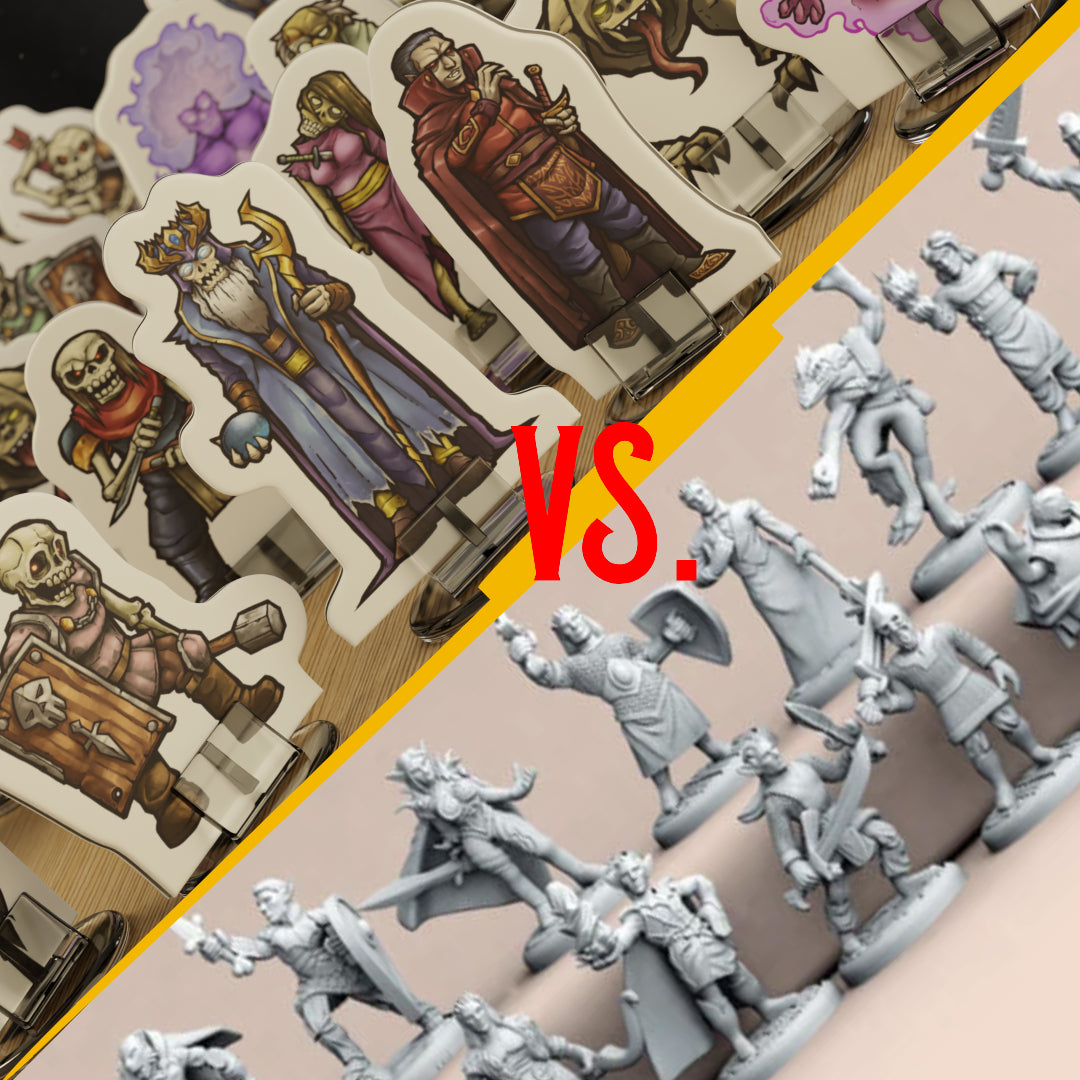Flat 2D vs. 3D Miniatures:
Finding Your Perfect Fit for Dungeons & Dragons

When it comes to playing Dungeons & Dragons, the visuals can be just as important as the story.
Miniatures bring life to the battlefield, helping players visualize the epic encounters and exciting moments that unfold within the campaign.
But with two main options available - flat 2D miniatures and plastic 3D miniatures - which one is right for you and your group?
Both types of miniatures have their own unique advantages and disadvantages.
Let's take a look at the pros and cons of each to help you decide which one is the perfect fit for your D&D adventures.
2D Miniatures: (pawns, standees, tokens)
Pros:
- Cost-effective: 2D miniatures are generally much, much cheaper than their 3D counterparts, making them a great option for players on a budget.
- Lightweight and portable: Flat miniatures are easy to store and carry, which is ideal for players who travel to their D&D sessions or game at different locations.
- Variety of styles and designs: 2D minis come in a wide variety of styles and designs, from classic fantasy art, to more modern and anime-inspired or cyberpunk illustrations. This gives players a large array of options to find miniatures that match their characters and the overall aesthetic of their campaign.
- Durability: 2D Flat minis are often very durable and much less prone to snapping a weapon or breaking a shield as 3D minis are.
- Easy to customize: 2D Standees can be easily customized with paint, markers, or other craft materials. This allows players to add their own personal touch to their miniatures and make them truly unique.
- Top-down view: 2D miniatures are perfect for games that use a top-down view, such as D&D 5th edition. This view allows players to see the entire battlefield at once and make strategic decisions based on the position of their characters and their enemies.
- Sustainability: some brands opt for planet friendly materials. Such as recyclable cardboard.
Cons:
- Art quality: Unless you’re buying very high-quality flat minis, the art often is low resolution, sadly. Think dollar store toy art. Make sure to buy high quality art.
- One sided: depending on the brand, they are often 1 sided. Or blurred on the backside. This is less immersive than it should be.
- Limited movement: 2D miniatures are typically limited to a single pose. This can be restrictive for players who want to express their characters' actions and emotions through their miniatures.
3D Miniatures:
Pros:
- Depth: 3D miniatures can provide a more immersive gaming experience. They have depth and dimensionality, which helps players visualize the scene and feel more connected to their characters.
- Greater range of movement: 3D miniatures sometimes come in a variety of poses, which allows players to express their characters' actions and emotions more effectively.
- Wide range of customization options: 3D miniatures can be painted, sculpted, and customized in a variety of ways. This allows players to create truly unique miniatures that stand out on the battlefield.
Cons:
- Much more expensive: 3D miniatures are typically more expensive than 2D miniatures. The cost can vary depending on the size, material, and complexity of the miniature.
- Bulkier and heavier: 3D miniatures are bulkier and heavier than 2D miniatures. This can make them more difficult to store and transport, especially for players who have a large collection.
- Limited variety: While there are a growing number of 3D miniature options available, the variety is still not as extensive as the variety of 2D miniatures. This can be a challenge for players who are looking for specific types of miniatures or characters.
- Requires painting: Unless you purchase pre-painted miniatures, you will need to paint your 3D miniatures yourself. This can be a time-consuming and challenging process, especially for players who are not experienced with painting miniatures.
- Durability: the longer edges and tips of 3D minis can often be brittle and break. Weapons and shields can break off. This requires more secure storage which ends up being much more bulky.
Choosing the Right Miniatures for You:
Ultimately, the best type of miniature for you and your D&D group depends on your individual needs and preferences.
Consider factors such as your budget, storage space, playing style, and desired level of immersion when making your decision.
Here are a few additional tips for choosing the right miniatures for your D&D games:
- Start with a small collection and add to it over time. This will help you save money and avoid having to purchase a large number of miniatures that you may not use.
- Look for miniatures that are high resolution, 2D or 3D, always opt for the higher resolution. Believe me, it's worth it. Nothing ruins a 2D/3D mini like a low quality design.


